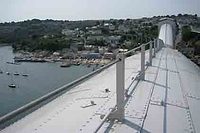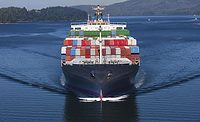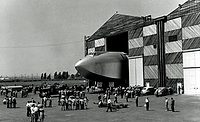Glass Flake Epoxy System Protects Historic Bridge

In terms of preserving important historic landmarks, the task of protecting the Royal Albert Bridge spanning the River Tamar in England presented a number of challenges, not least the number of rivets, back-to-back angles and the chains.
Designed by Brunel and completed in 1859, the bridge provides the only rail connection between Cornwall and the rest of England. Opened by His Royal Highness Prince Albert, this industrial-looking structure with spindly piers and beefy tubular arches retains a period elegance and appeal, while still providing the route for modern rail transport.
The bridge presented a number of painting challenges: the tubular arches are made up of many riveted plates, and the internal surfaces of the chains required special attention. The environment is aggressive due to the relatively high levels of humidity and salinity from the tidal river below, so the specified protective system had to provide a protective envelope that will give 25 years anti-corrosion protection.
Solution
Based on the successful application of glass flake epoxy systems used to repaint the Forth and Tay Rail Bridges, Network Rail decided to continue along these lines and specified a glass flake epoxy system. The main contractor, Taziker Industrial Coatings, selected Sherwin-Williams Protective & Marine Coatings as its paint supplier.
The existing paintwork was totally removed by abrasive blast-cleaning. The coating system comprised Metagard L674 Epoxy Blast Primer at 50 um minimum dry film thickness (mdft), Epigrip C123 Glass Flake Epoxy at 400 um mdft and Resistex C137V2 Acrylic Urethane Finish at 50 um mdft. A stripe coat of Epigrip C123 Glass Flake Epoxy was applied at 250 um mdft between the first and second coats to all rivets, sharp edges and joints, etc. A total minimum dry film thickness of 500 um was applied.
Working over a live railway, the applicators applied the stripe coat by brush to all rivets and sharp edges. The internal surfaces of the chains were coated using a roller, all the other coats were applied by airless spray.
Damian Smith, of the contractor Taziker Industrial Coatings, said, “This was a particularly challenging project, especially with the chains and rivets we had to treat, and we ended up applying this part of the coating using an adapted roller system. All in all, this was both effective and impressive in its application.”
Summary
Originally developed to protect offshore structures from the severe marine environment in North Sea oil and gas applications, the epoxy glass flake resin system adapted well for this purpose.
The system eliminated the need for ongoing maintenance, significantly reducing environmental impact, saving on repair costs and extending asset life.
The three-coat preventative maintenance coating system provides excellent adhesion and anti-corrosion properties, and acts as a powerful barrier against the harsh weather conditions in this aggressive marine environment.
This technology – first used to famously complete the painting of the Forth Rail Bridge in 2001 to 2011 – has put glass flake epoxy-based systems at the forefront of bridge painting.
The benefits to customers of adapting this system to the bridge and highways sector comes in terms of labor costs, lower energy usage and volumes of paint required. In addition, the higher volume solids used in the coatings system mean that fewer volatile organic compounds (VOCs) were emitted during the process.
Sherwin-Williams’ glass flake epoxy coatings are now featured in a number of other large bridge and highway projects, including 47 bridges across the M6 Toll Road, the Tay Rail Bridge and Blackfriars Bridge.
Using glass flake technology to provide a thicker dry film in a single coat, the coatings system can be modified to meet the requirements of the customer in terms of cost effectiveness, application and finish. The selected paints typically consist of a higher build blast primer, an epoxy glass flake build coat and an acrylic urethane finish, as well as a stripe coat of epoxy glass flake.
Dawn Welsh, of Network Rail, said, “This project means the bridge can continue to be used for years to come without further major coatings maintenance. We’re especially pleased with the combination of the protection and the finish this has given to the bridge.”
Dave Bottomley, of Sherwin-Williams Protective & Marine Coatings, said, “Frequently subject to harsh environments, including high winds and salt-laden sea mists, the ongoing maintenance of many bridges carries significant costs and environmental implications. By transferring our innovative coatings technologies across markets, the need for service and maintenance has been reduced and the asset life extended. The difference to the Royal Albert Bridge can be seen by everyone, and the protection offered will make sure that it can stand proudly for many years to come.”
Looking for a reprint of this article?
From high-res PDFs to custom plaques, order your copy today!








